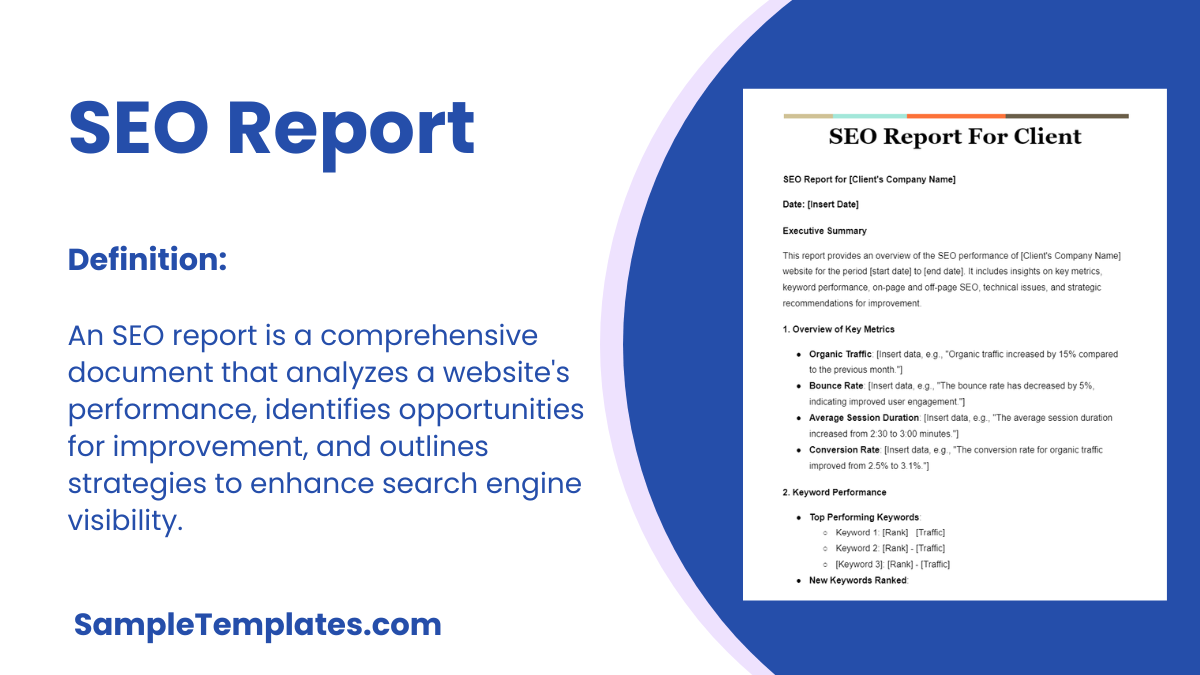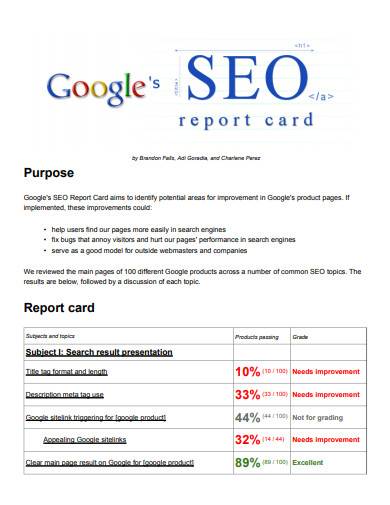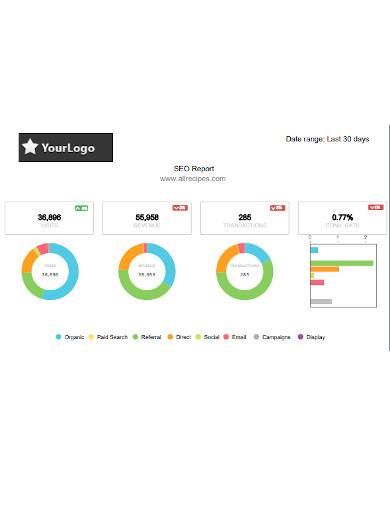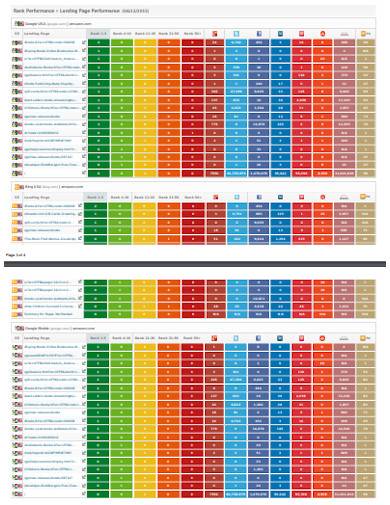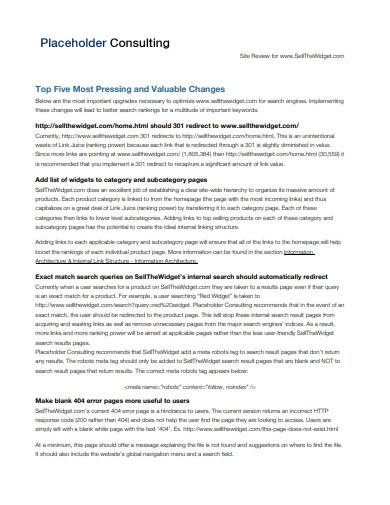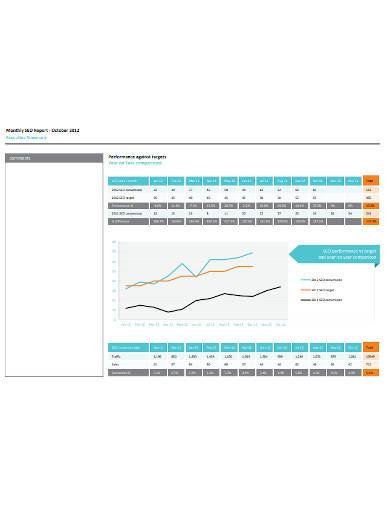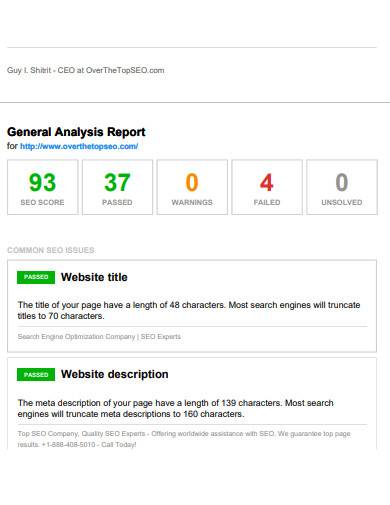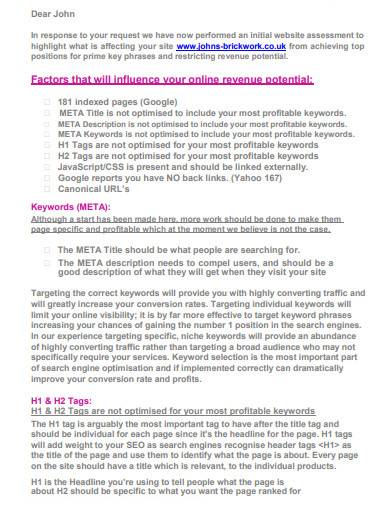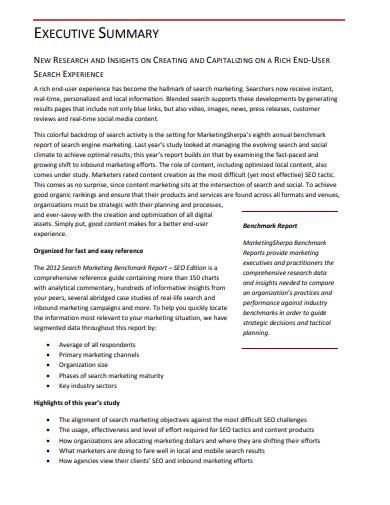The online market is lucrative yet saturated. Therefore, if you operate an online store or sample planning to start one, conduct more specialized market research, competitor analysis and create a marketing strategy that will make your website stand out from the rest of the big players in the industry. With these essential business actions, you’ll soon discover that you need to learn modern tools connected to SEO. And if you happen to work for a client whose website traffic needs some push, you will need to obtain an SEO report, which we are about to tackle.

SEO Report Generator
Report Date: [Current Date]
Reporting Period: [Date Range]
Executive Summary
Overview: Summarize the key findings, overall SEO health, and performance of the website over the reporting period. Highlight significant changes in traffic, rankings, and any major SEO initiatives undertaken.
Key Achievements:
- Increased organic traffic by X%.
- Improved rankings for key target keywords.
- Successfully implemented technical SEO improvements (e.g., page speed optimization).
Areas for Improvement:
- Reduce high bounce rates on key landing pages.
- Address missing alt tags and broken links found in the audit.
- Enhance content quality on underperforming pages.
1. Traffic Analysis
Total Organic Traffic: Provide the total number of organic sessions, users, and page views. Compare these numbers with the previous period and explain significant changes.
Traffic Sources: Break down traffic by source (organic, referral, direct, paid, social) to show how visitors are finding the site.
Top Performing Pages: List the pages that receive the most traffic and discuss why they perform well.
Visuals:
- Line graph of traffic trends over time.
- Pie chart of traffic sources.
2. Keyword Performance
Top Ranking Keywords: List keywords that rank in the top 10, including their current position, search volume, and previous position.
Keyword Gains and Losses: Highlight keywords that have improved in ranking and those that have dropped, providing insights into possible reasons.
Visuals:
- Table of top keywords with rankings and changes.
3. On-Page SEO Elements
Meta Tags Analysis: Review effectiveness of title tags and meta descriptions. Headings and Content Analysis: Evaluate use of H1 and H2 tags, keyword density, and content relevance. Images and Alt Text: Assess image optimization and alt text usage.
4. Technical SEO
Site Speed: Report on load times for desktop and mobile. Mobile Usability: Discuss mobile responsiveness and any issues affecting mobile users. Site Errors: Detail any 404 errors, broken links, or crawl errors identified.
Visuals:
- Screenshots of site speed scores from tools like Google PageSpeed Insights.
5. Backlink Analysis
Total Backlinks and Referring Domains: Provide counts and compare with previous periods. New and Lost Backlinks: Identify newly acquired backlinks and those that were lost, discussing their potential impact. Link Quality: Analyze the authority and relevance of linking domains.
Visuals:
- Bar chart showing the trend of backlinks over time.
6. Competitor Analysis
Competitor Rankings: Compare keyword rankings with main competitors. Competitor Site Features: Discuss any notable site features or content strategies used by competitors.
7. Recommendations and Action Items
Short-Term Actions: Immediate steps to address any critical issues identified in the report. Long-Term Strategy: Strategic initiatives to improve overall SEO performance, such as content development, link building campaigns, or technical optimizations.
Conclusion
Summarize the overall health of the website’s SEO and reinforce the importance of the recommended actions. Emphasize the anticipated benefits of implementing these strategies.
This structured format helps to clearly communicate the findings of an SEO audit and provides a clear roadmap for future efforts to enhance the website’s search engine performance.
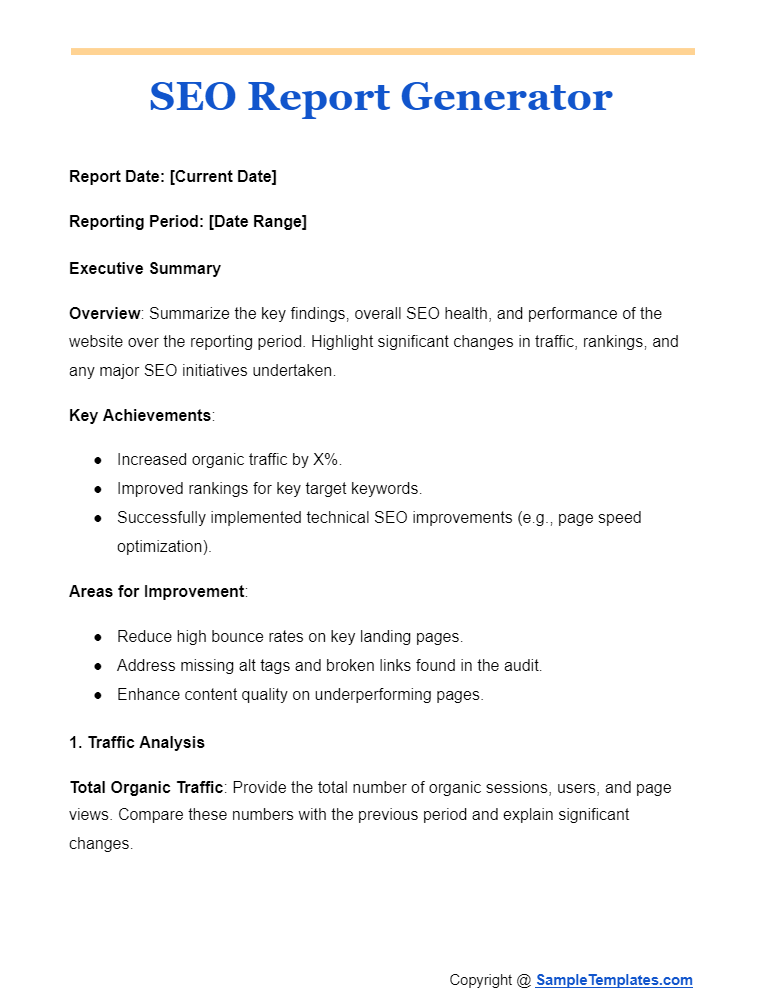
SEO Report for Client
SEO Report for [Client’s Company Name]
Date: [Insert Date]
Executive Summary
This report provides an overview of the SEO performance of [Client’s Company Name] website for the period [start date] to [end date]. It includes insights on key metrics, keyword performance, on-page and off-page SEO, technical issues, and strategic recommendations for improvement.
1. Overview of Key Metrics
- Organic Traffic: [Insert data, e.g., “Organic traffic increased by 15% compared to the previous month.”]
- Bounce Rate: [Insert data, e.g., “The bounce rate has decreased by 5%, indicating improved user engagement.”]
- Average Session Duration: [Insert data, e.g., “The average session duration increased from 2:30 to 3:00 minutes.”]
- Conversion Rate: [Insert data, e.g., “The conversion rate for organic traffic improved from 2.5% to 3.1%.”]
2. Keyword Performance
- Top Performing Keywords:
- New Keywords Ranked:
- Keywords to Improve:
- Keyword 1: [Current Rank] – [Suggested Actions]
3. On-Page SEO Analysis
- Content Quality: [Summary of content performance, including high-performing pages and those needing updates]
- Meta Tags: [Analysis of title tags, meta descriptions, and headers]
- Internal Linking: [Overview of internal link structure and suggestions for improvement]
- User Experience: [Insights on site navigation, mobile responsiveness, and page load speed]
4. Off-Page SEO Analysis
- Backlink Profile:
- Total Backlinks: [Number]
- Referring Domains: [Number]
- High-Quality Backlinks: [Overview]
- Toxic Backlinks: [Overview and actions taken or recommended]
- Social Media Signals: [Summary of social media impact on SEO, if applicable]
5. Technical SEO Analysis
- Site Speed: [Page speed insights, including load times and areas for improvement]
- Mobile Usability: [Mobile-friendliness analysis and recommendations]
- Crawl Errors: [Summary of crawl errors found and fixed]
- Sitemap and Robots.txt: [Status of sitemap and robots.txt file]
6. Competitor Analysis
- Competitor Overview: [List of main competitors]
- Comparative Metrics:
- Organic Traffic Comparison: [Summary]
- Keyword Overlap: [Summary]
- Backlink Comparison: [Summary]
- Opportunities: [Identify gaps and opportunities based on competitor analysis]
7. Recommendations and Action Plan
- Content Strategy: [Suggestions for new content, updates, and optimization]
- Technical Improvements: [List of technical issues to fix and improvements to implement]
- Link Building Strategy: [Plan for acquiring high-quality backlinks]
- Keyword Strategy: [Recommendations for targeting new keywords and improving existing ones]
8. Next Steps
- Implementation Timeline: [Outline of immediate actions, short-term goals, and long-term strategies]
- Follow-Up: [Schedule for the next report and follow-up meetings]
Prepared by:
[Your Name]
[Your Title]
[Your Company Name]
[Contact Information]
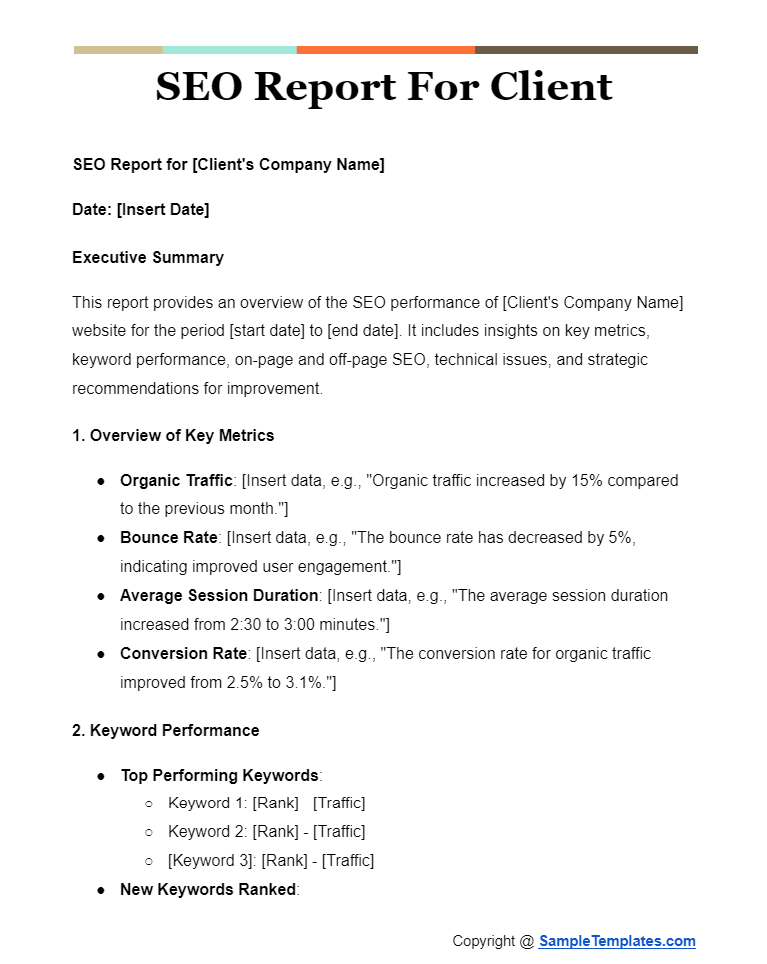
SEO Report Online
SEO Performance Report
Company: [Company Name]
Reporting Period: [Start Date] – [End Date]
Report Prepared By: [Your Name or Team]
Executive Summary
This report provides a comprehensive overview of the SEO performance for [Company Name] during the specified period. Key areas of focus include traffic analysis, keyword performance, backlink profile, and actionable recommendations for future strategy enhancements.
1. Website Traffic Overview
- Total Visits: [Number]
- Organic Traffic: [Number]
- Traffic Change: [Percentage Increase/Decrease]
- Conversion Rate: [Percentage]
Insight: Traffic trends from organic search have [increased/decreased], indicating [possible reasons such as seasonality, marketing campaigns, algorithm updates].
2. Keyword Performance
- Total Keywords Ranked: [Number]
- Top Performing Keywords: [List Top 5 Keywords]
- Keywords Gained: [Number], [Example Keywords]
- Keywords Lost: [Number], [Example Keywords]
Insight: The shift in keyword rankings suggests [analysis, e.g., the impact of recent content updates or competitors’ actions].
3. Page Performance
- Top Pages by Traffic: [List Top 5 URLs]
- Average Time on Page: [Average Time]
- Bounce Rate: [Percentage]
Insight: High-performing pages [discuss why they perform well, such as quality content, effective SEO practices] while pages with high bounce rates may need [suggestions for improvement].
4. Backlink Analysis
- Total Backlinks: [Number]
- New Backlinks Acquired: [Number]
- Lost Backlinks: [Number]
- Top Referring Domains: [List Top 5 Domains]
Insight: The backlink profile has [improved/deteriorated], influencing domain authority and search rankings. Focus on [strategies to improve backlinks, such as content marketing or outreach].
5. Technical SEO Audit
- Site Speed: [Average Load Time]
- Mobile Usability: [Issues Found/None]
- SEO Errors: [List Critical Errors]
Insight: Technical issues such as [list issues] could be negatively impacting user experience and SERP rankings. Immediate action is recommended.
6. Competitor Benchmarking
- Primary Competitors: [List Competitors]
- Competitor Keyword Overlap: [Details]
- Competitor Traffic Estimate: [Comparison]
Insight: Understanding competitor strategies in [mention specific areas such as content or backlinks] can uncover opportunities for differentiation and growth.
7. Recommendations and Next Steps
- Keyword Optimization: Focus on [specific actions].
- Content Development: Increase efforts in [specific types of content].
- Link Building: Enhance backlink profile by [specific methods].
- Technical Improvements: Address [specific issues] immediately.
Conclusion
Overall, [Company Name]’s SEO performance has shown [positive/negative/stable] trends. By addressing the outlined areas for improvement and continuing to build on current strengths, we can further enhance our online visibility and search engine rankings
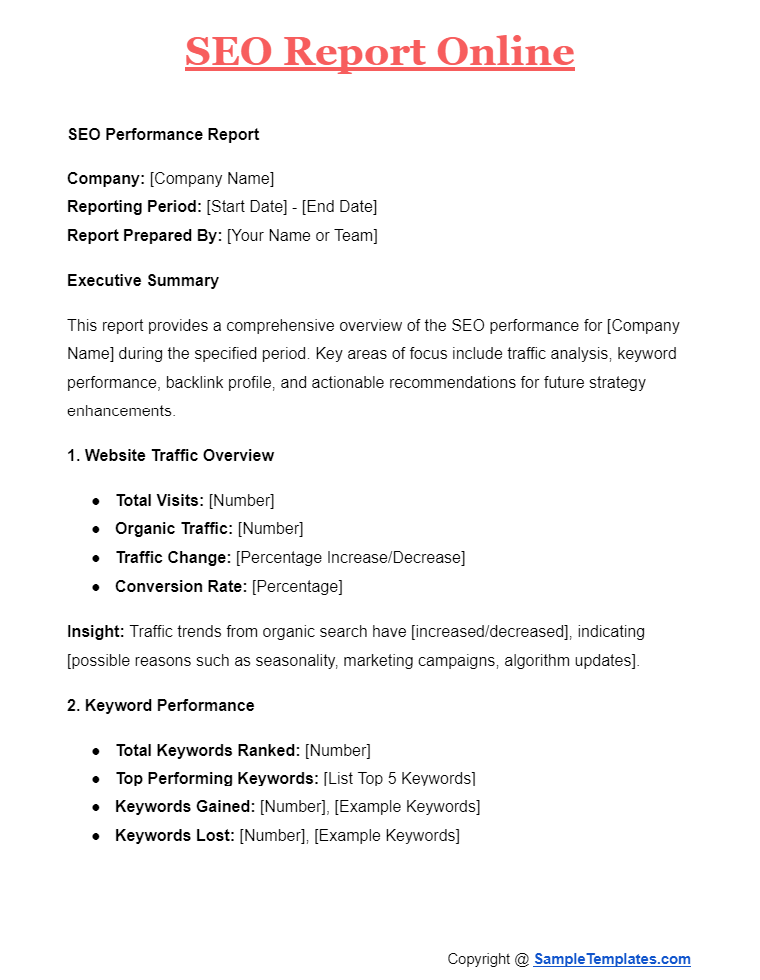
SEO Report for Website
SEO Performance Report
Website: [YourWebsite.com]
Reporting Period: January 1, 2024 – March 31, 2024
Prepared by: [Your Name or Your Company’s Name]
Executive Summary
This SEO report provides a comprehensive overview of [YourWebsite.com]’s performance in search engine rankings, highlighting successes, challenges, and areas for strategic improvement. The primary focus is on organic traffic, keyword rankings, page performance, backlinks, and user engagement metrics.
1. Traffic Overview
- Total Organic Sessions: 15,000 (Increase of 5% from the previous quarter)
- New Users: 11,000 (Increase of 10% from the previous quarter)
- Page Views: 45,000 (Increase of 3% from the previous quarter)
Analysis: The increase in organic sessions and new users indicates successful keyword targeting and improved search engine visibility.
2. Keyword Performance
- Top Performing Keywords: “best [product type] for [use case],” “affordable [product category],” “[specific service] near me”
- Improved Rankings: 150 keywords improved their rankings
- Declined Rankings: 20 keywords have lower rankings
Analysis: Most keywords have shown improvement. The decline in some could be due to increased competition or changes in search algorithms.
3. Page Performance
- Best Performing Page: [URL of the Best Performing Page]
- Average Load Time: 2.1 seconds (Improved by 0.5 seconds)
- Bounce Rate: 45% (Decrease of 5%)
Analysis: The improvement in page load time likely contributed to the lower bounce rate and better user engagement.
4. Backlink Analysis
- Total Backlinks: 5,200 (Increase of 8%)
- High-Quality Backlinks: 80% are from high-authority sites
- Lost Backlinks: 50 (mainly from low-authority sites)
Analysis: The growth in quality backlinks has likely boosted domain authority, but ongoing efforts are needed to replace lost links.
5. Technical SEO
- Mobile Usability: 98% mobile-friendly (Increase of 2%)
- HTTPS Security: 100% secure
- SEO Errors Detected: 7 critical errors (e.g., broken links, duplicate content)
Analysis: Immediate attention to SEO errors will prevent potential penalties and loss of rankings.
6. Conversion Metrics
- Total Conversions: 300 (Increase of 20% from the previous quarter)
- Conversion Rate: 2% (Increase of 0.4%)
Analysis: Enhanced site performance and user experience have positively impacted conversion rates.
Recommendations for Next Quarter
- Keyword Optimization: Focus on underperforming keywords and explore new long-tail opportunities.
- Content Enhancement: Update the top 10 lowest-performing pages with fresh content and improved keyword integration.
- Backlink Strategy: Initiate a guest blogging outreach program to gain more high-quality backlinks.
- Technical Improvements: Address the critical SEO errors and improve site architecture to enhance crawlability.
- Conversion Optimization: Test different call-to-action placements and messages to further boost conversions.
Conclusion
This quarter has shown positive trends in traffic, user engagement, and conversions. The strategic recommendations provided aim to build on these successes and address areas needing improvement to continue driving organic growth and improving ROI.
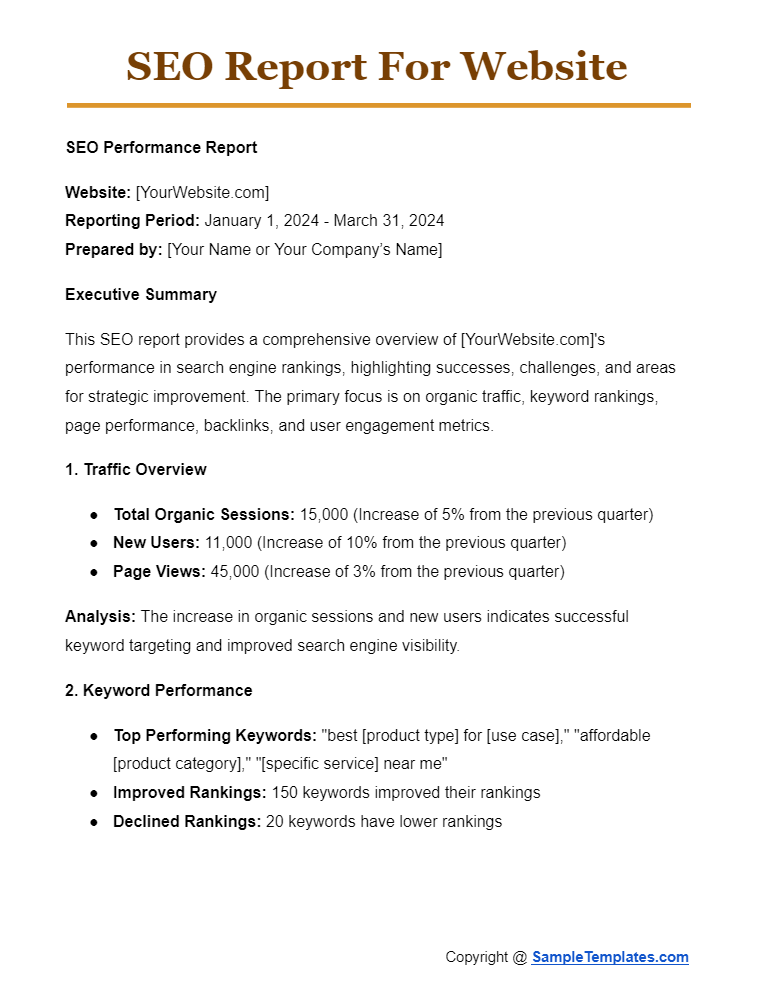
Browse More Templates On SEO Report
Create a smart SEO report by using the best SEO report template for your client. Start by taking a look at the SEO report examples and templates that we have gathered in this section. You can also check out our article about business report samples if you want to explore the type of reports you can create for your client’s needs.
1. Sample SEO Report Template

2. SEO Audit Report Template
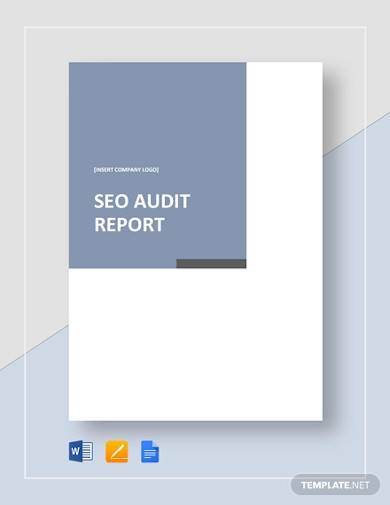
3. SEO Analysis Report Template

Benefits of an SEO Report
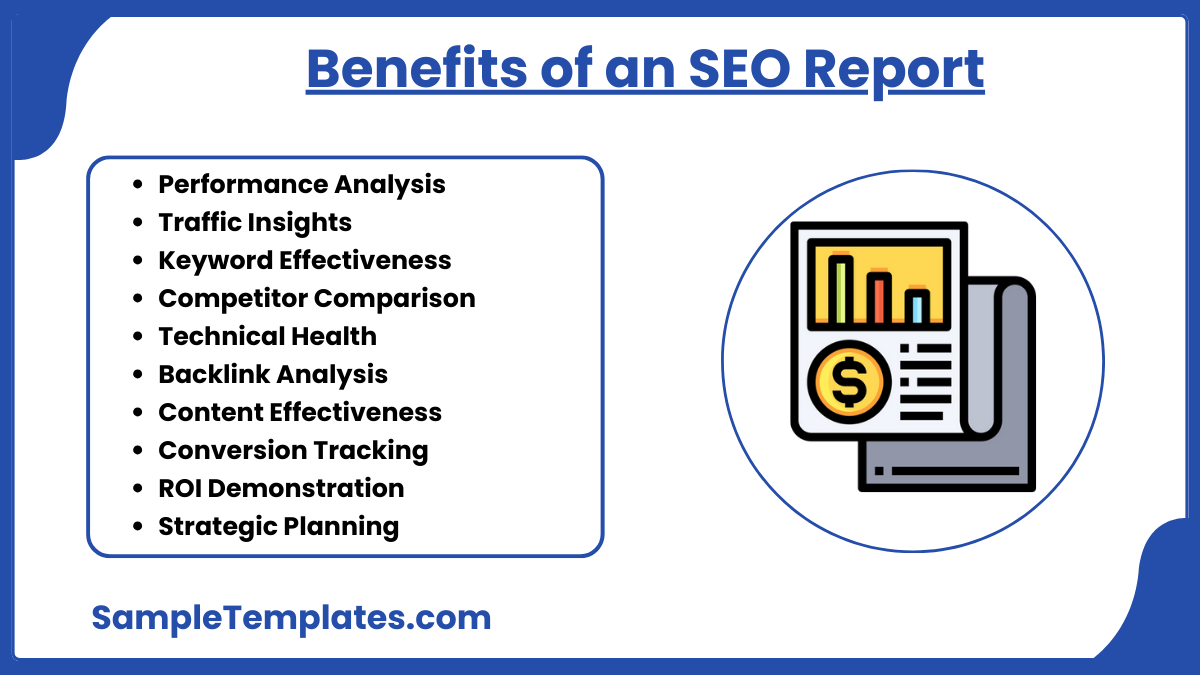
An SEO (Search Engine Optimization) report is a critical tool for businesses and digital marketers that helps evaluate and improve the performance of a website in search engine results. Here are several key benefits of an SEO report:
- Performance Analysis: SEO reports provide insights into how well a website ranks for specific keywords and phrases in search engine results. This allows marketers to see which strategies are working and where adjustments are needed.
- Traffic Insights: These sample reports detail the sources of web traffic, be it through organic search, paid ads, social media, or referrals. Understanding these sources helps in optimizing marketing strategies to attract more visitors.
- Keyword Effectiveness: SEO reports show which keywords are driving traffic to the site, which ones are underperforming, and potential opportunities for new keywords. This helps in refining SEO tactics to target more relevant keywords that can increase visibility and attract the right audience.
- Competitor Comparison: Many SEO reports include a competitor analysis that highlights how a site stacks up against its competitors in terms of rankings, keyword usage, and other SEO factors. This information is invaluable for benchmarking and setting realistic SEO goals.
- Technical Health: SEO reports often assess the technical aspects of a website, such as site speed, mobile-friendliness, and URL structure. Identifying and fixing these issues can significantly improve user experience and site performance in search rankings.
- Backlink Analysis: Understanding the site’s backlink profile—including the number and quality of backlinks—is crucial for SEO success. SEO reports can identify potentially harmful links and highlight opportunities for acquiring more high-quality links.
- Content Effectiveness: By analyzing metrics such as page views, bounce rates, and average time on page, SEO reports help determine which pieces of content are most engaging and effective at retaining visitors.
- Conversion Tracking: Beyond just attracting visitors, effective SEO also aims to convert visitors into leads or customers. SEO reports can track conversions from organic search and help understand how SEO contributes to the overall business goals.
- ROI Demonstration: For businesses investing in SEO, these reports provide tangible data to demonstrate the return on investment. This is crucial for justifying the ongoing expense involved in SEO campaigns.
- Strategic Planning: With all the data compiled in an SEO report, businesses can make informed decisions about their future marketing and web development strategies. This planning can be directed towards enhancing areas of weakness and leveraging strengths more effectively.
Overall, an SEO report is essential for any sample business that aims to improve its online presence. It provides a detailed overview of current performance and offers actionable insights for strategic improvement.
4. SEO Report Card Template
5. Website Ranking and SEO Report
6. Rank Process SEO & Marketing Report
7. Domain Audit SEO Report Sample
Tips For Creating an SEO Report
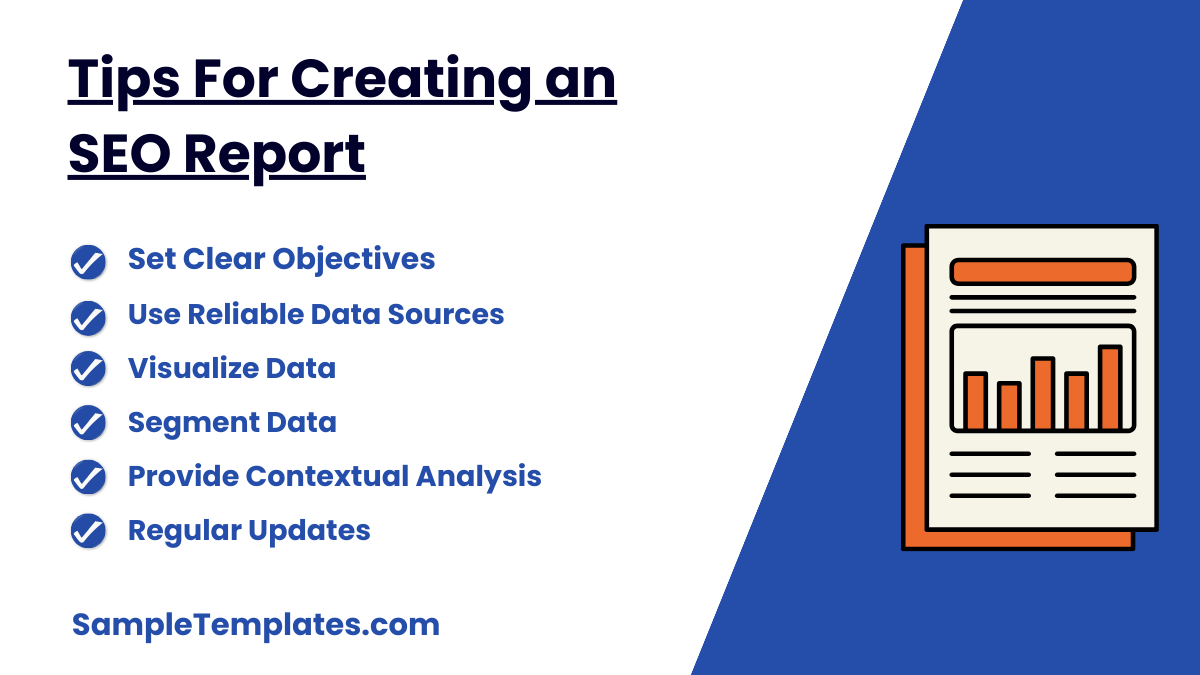
Creating an effective SEO report outline requires a balance of comprehensive data and clear, actionable insights. Here are some tips to help you craft a valuable SEO report:
- Know Your Audience: Tailor the report to the needs and knowledge level of the audience. For example, a report for a technical team might focus on backend issues like site speed and security, whereas a report for executives might emphasize ROI and overall traffic growth.
- Set Clear Objectives: Define what the SEO report aims to achieve. Are you focusing on the effectiveness of recent changes, overall performance trends, or specific areas like mobile SEO? Setting objectives helps determine which data to include.
- Use Reliable Data Sources: Base your formal report on data from trusted SEO tools and analytics software such as Google Analytics, Google Search Console, SEMrush, Ahrefs, or Moz. These tools provide accurate and detailed insights into various aspects of SEO performance.
- Include Key Performance Indicators (KPIs): Identify and include KPIs that align with your SEO goals. Common KPIs include organic traffic, keyword rankings, page load time, bounce rate, conversion rate, and backlink quality and quantity.
- Provide Contextual Analysis: It’s not enough to present data; you need to analyze it. Explain why certain metrics have changed and how these changes impact the overall SEO strategy. This could involve discussing algorithm updates, technical issues, or content modifications.
- Visualize Data: Use charts, graphs, and tables to make your data easier to understand. Visual aids can help highlight trends, comparisons, and growth patterns that are crucial for storytelling and decision-making.
- Segment Data: Break down data by categories such as traffic source, device type, or geographic location. This can reveal insights that are obscured when viewing aggregate data and can guide more targeted SEO strategies.
- Discuss Competitor Performance: If relevant, include a competitor analysis to show how your site stacks up against others in your industry. This can provide motivation and direction for SEO efforts.
- Highlight Achievements and Areas for Improvement: Clearly state what’s working well and what isn’t. This helps focus future SEO efforts on successful tactics and areas that need more attention.
- Recommend Actions: Conclude your report with clear, actionable recommendations based on the data analyzed. This could be optimizing specific pages, revising content, building more backlinks, or addressing technical issues.
- Regular Updates: SEO is an ongoing process. Regularly update your reports to track progress and adjust strategies as necessary. This could be monthly, quarterly, or on another regular schedule that fits your SEO goals and business model.
- Executive Summary: Start with a summary that captures the main points of the report, especially if it’s intended for higher-ups or clients who may not delve into all the technical details.
By following these tips, you can ensure that your SEO report not only conveys the necessary information but also engages the audience and drives effective decision-making.
8. Monthly SEO Report Template
9. SEO General Analysis Report Sample
10. SEO Analysis Report Sample
11. Search Marketing Report Template
What Is an SEO Report?
SEO reports are a document that gives you a summary of how a website performs in search engines. This crucial business report can specifically provide you information, such as website rankings, organic traffic, domain metrics, and the existing SEO agency works for the websites in your industry.
How To Create an SEO Report that Will Suffice Your Client’s Needs?
Similar to creating a compliance report, you need to create an SEO report to suffice someone’s needs. Only this time, this someone is your client. Take note of the following tips to ensure that the SEO report that you will create will satisfy your client.
1. Determine Where the Website Traffic Comes From
Whatever the specific goal of your client is to boil down to where his or her website visitors come from. Therefore, you need to include website traffic source in your report. There are many SEO reporting tools that you can find online to serve this action for you. However, the most popular ones are Firebase and Google Analytics. In fact, according to Statista, 81% of Android apps use Firebase, while 30% uses Google Analytics, making these two as the leading analytics software development kits(SDK).
2. Convert the Website Traffic
Website traffic doesn’t guarantee profits. Conversion does, which is why clients are very particular with this matter. Thus, it is essential to include it in your SEO plan. By determining the conversion rate of the website traffic, you can easily explain the rest of the SEO report. Conversion refers to the process where the website visitor does what you intend them to do, such as clicking a button at the bottom of the page, which routes to the “add to cart” page.
3. Make an Action Plan
At this point, you already know where the website visitors are coming from. With this information, you can determine what these users are doing by analyzing what they are doing on the previous page they visit and deciding what these people wanted that they proceed to your product page. By doing so, you can create an action plan on what to do to improve it. Perhaps, you will determine that adding videos in the article will enhance the users’ engagement.
4. Provide Visitors with Great Experience
Page loading speed is one of the things that your website visitors will notice when they are on your page. Therefore, it is essential to show them that your page loads faster than the others. Optimize the size of the images that it loads. Perhaps, disable the video auto-play function. There are many SEO report tool that you can use to determine what needs to be done for your page to improve its performance, such as Google Page Speed Insight.
FAQs
How can you say that an SEO report is effective
The clients are willing to pay if they see results. To achieve these intended results, take note of the following aspects.
Progress
Your client indeed wishes to see the final results. However, there are indicators that they will see one even before the final results come. That is by checking progress. As an SEO professional, you need to take into account the progress of your work as well. This progress should show in the report. You can also check our article about sample weekly progress reports if you want to know how to put this progress in writing.
Insights
An effective SEO report should provide information about the possible future issues that a client may encounter. With this information, it will be easier to determine the third aspect of an effective SEO report.
Recommendations
A recommendation is the third aspect that you should consider if you intend to create an SEO report that will serve great value to your client.
What is SEO analysis?
Through SEO analysis tool, you can determine the reasons that are keeping you from getting a high ranking in search engines like Google and Bing. With this analysis, you can determine what you need to include in your SEO strategy to earn a high site ranking.
What is SEO?
SEO stands for Search Engine Optimization, referring to the techniques and strategies that SEO professionals utilize to secure a high ranking placement in search engine results, which will increase the traffic to their website. If you want to get a job in this department, read our article about SEO resume templates in PDF format.
What is an SEO tool?
SEO tools are the tools that you can use to support SEO goals, such as keyword analysis, site ranking tools, content ideas, link building, link removal, and technical SEO.
The market of various business industries is gradually integrating into online platforms. Therefore, if you are handling a business that is heavily relying on brick and mortar market, you should consider modifying your market research plan to include online market to its target market and start taking a look at the SEO proposals that you may want to employ for your business. By doing so, you will discover potential additions to your market. In this article, you have hit the tip of an iceberg, which should be enough to get you started.
Related Posts
School Accomplishment Report Samples & Templates
Field Report Samples & Templates
Sample Science Project Reports
Business Report Samples & Templates
Survey Reports Samples & Templates
Sample Feasibility Reports
Psychological Assessment Report Samples [ Clinical, Child, Intake ]
Report Format Samples & Templates
Acknowledgement for Internship Report Samples [ Hotel, Hospital, Teaching ]
Field Trip Report Samples [ Agriculture, Educational, Environmental ]
Student Counseling Report Samples
Narrative Accomplishment Report Samples [ Science, Teacher, Reading ]
Sample Acknowledgment Report Templates
Internship Narrative Report Samples
Interview Summary Report Samples
